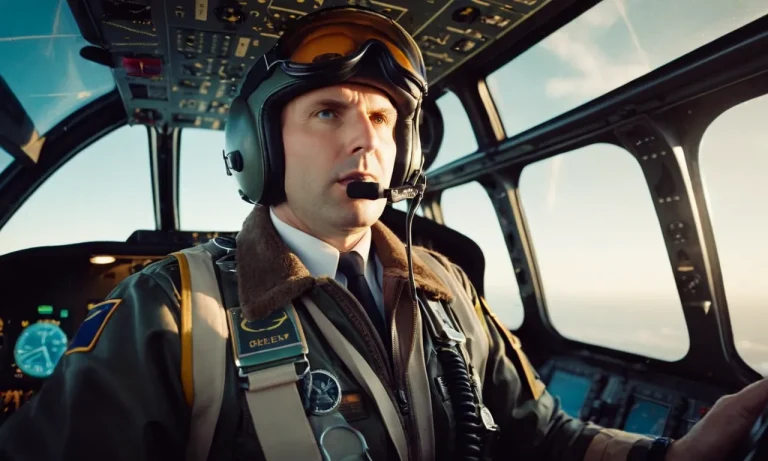What Do Pilots Say When Landing A Plane?
Whether you’re a frequent flier or just boarding your first flight, you’ve probably heard pilots make announcements before takeoff and landing. But when pilots communicate with air traffic control as they guide giant metal tubes full of passengers back to the ground, it can sound like they’re speaking another language entirely.
If you’re short on time, here’s the quick answer to what pilots say when landing: Pilots use standardized phraseology to communicate vital information to air traffic controllers as they descend, approach the runway, and finally touch down.
Key terms include altitude callouts, speed adjustments, landing gear positions, and clearance readings.
Descending Toward the Airport
As a plane prepares to land, the pilot and co-pilot go through a series of protocols and communications to ensure a safe and smooth landing. One of the crucial moments during this process is when the aircraft begins its descent toward the airport.
This is when the pilots start to communicate with the air traffic control (ATC) and provide important updates regarding their altitude and position.
Calling Out Altitudes
During the descent, pilots are required to call out specific altitudes to the ATC. This helps the air traffic controllers monitor the aircraft’s progress and ensure proper separation between other planes in the vicinity.
The altitudes are typically called out in 1,000-foot increments, such as “passing 10,000 feet,” “passing 9,000 feet,” and so on. These altitude reports help the ATC keep track of the plane’s descent and make necessary adjustments to maintain a safe distance between aircraft.
Reporting Positions
In addition to calling out altitudes, pilots also report their positions to the ATC during the descent. This is especially important when there are multiple runways at the airport or when the aircraft needs to join a specific approach path.
Pilots will provide information on their location in relation to the airport, such as “established on the localizer” or “crossing the outer marker.” These position reports help the ATC guide the aircraft safely toward the designated runway and coordinate with other traffic in the area.
It’s important to note that the exact phrases used by pilots may vary depending on the specific procedures and regulations of each country or airline. However, the general principle remains the same – clear and effective communication between pilots and ATC is essential for a safe and successful landing.
Lining Up the Approach
Adjusting Speed
When pilots are preparing to land a plane, one of the first things they do is adjust the speed. This is crucial for a safe landing as it allows the aircraft to descend at the appropriate rate. Pilots use various instruments and calculations to determine the optimal speed for landing.
They take into account factors such as wind speed, the weight of the aircraft, and the length of the runway. By carefully monitoring and adjusting the speed, pilots ensure a smooth and controlled descent.
Configuring the Aircraft
In addition to adjusting the speed, pilots also configure the aircraft for landing. This involves making changes to the flaps, landing gear, and other control surfaces to optimize the aircraft’s performance during the approach and touchdown.
The configuration may vary depending on the type of aircraft and the specific runway conditions. Pilots rely on their training and experience to select the appropriate configuration for each landing.
Requesting Landing Clearance
Before landing, pilots must obtain clearance from air traffic control (ATC). This is done by contacting the tower and requesting permission to land. The pilot will provide information such as the aircraft’s identification, current position, and intentions.
ATC then grants landing clearance based on factors such as airspace congestion and runway availability. Once landing clearance is obtained, the pilot can proceed with the final stages of the approach and landing.
For more information on the intricacies of landing a plane, you can visit FAA.gov which provides valuable resources and guidelines for pilots.
Coming in for Landing
Landing an airplane is a critical phase of flight that requires a pilot’s utmost attention and precision. Throughout this process, pilots communicate with air traffic controllers and their fellow crew members to ensure a safe and smooth landing.
Let’s take a closer look at some of the phrases and commands pilots use when coming in for a landing.
Gear Down
One of the first things pilots say when preparing for landing is “Gear Down.” This phrase refers to the extension of the landing gear, which consists of the wheels and supporting structures that allow the aircraft to touch down safely.
By confirming that the landing gear is down and locked in place, the pilot ensures a stable landing.
On Glide Slope
As the aircraft approaches the runway, pilots aim to maintain a precise descent path known as the glide slope. Pilots use the phrase “On Glide Slope” to indicate that the aircraft is at the correct vertical angle for landing.
This helps ensure that the aircraft touches down smoothly and at the intended touchdown point on the runway.
Cleared to Land
Prior to landing, pilots must receive clearance from air traffic control to proceed with the landing. The phrase “Cleared to Land” is used to indicate that the runway is clear and the pilot has permission to land.
This communication is essential for maintaining safe separation between aircraft and coordinating arrivals and departures at the airport.
It’s important to note that these phrases are just a few examples of the communication that occurs during the landing phase. Pilots and air traffic controllers have a standardized set of phraseology and procedures to ensure effective communication and safe operations.
If you’re interested in learning more about aviation phraseology and procedures, you can visit the Federal Aviation Administration (FAA) website for detailed information.
Rolling Out and Taxiing
Touching Down
As the plane’s wheels make contact with the runway pavement, the pilot will say “spoilers up” to command the spoilers to rise. Spoilers are plates on the wings that help to kill lift and put more weight on the wheels for better braking.
The increased drag created by the spoilers also helps to slow down the plane.
Once slowed sufficiently, the pilot will say “reverse thrust” to command the engines into reverse, blowing air forward to create drag and stopping power. The landing however is not over yet, as the pilot must still bring the speeding aircraft to a complete stop and clear the runway for the next incoming flight.
Exiting the Runway
After lowering the nose wheel, the pilot will attempt to exit the runway as quickly as possible, saying “exiting left/right” to indicate direction to the control tower and crew. A swift runway exit helps prevent runway incursions and allows a tighter traffic flow of planes taking off and landing.
Before reaching the taxiway, the pilot will disable the reverse thrusters and announce “reversers off“. After turning off the runway, they will say “clear of runway” to officially transfer control from tower to ground control. The landing roll is now fully complete.
Taxi Instructions
While taxing to the gate after clearing the runway, pilots communicate with ground control, acknowledging taxi instructions such as “taxi to gate Alpha-3“. Ground crews signal to the aircraft with illuminated wands guiding their turns. Some fun aviation phrases ground control may say are:
- “Taxi via Alpha, Bravo, Charlie” to designation taxiways
- “Hold short of Runway 27” to halt before runway entry
- Cross Runway 27, “no delay” if urgent
The first officer will keep their eyes outside while the captain confirms each instruction read back properly to ground control. Following all clearances avoids congestion and runway incursions. After a long flight, the sweetest words a pilot hears are “welcome to gate” as parking brakes are set. 😊👍✈️
Conclusion
So the next time you’re buckling up for departure or feeling those landing gears thump down, listen closely. The terminology might sound technical, but each callout and confirmation allows pilots and controllers to safely choreograph the awe-inspiring dance of modern air travel.








